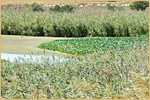|
|
 |
 |
|
|
 |
 |
 |
|
Member of the Wildlife & Environment
Society of South Africa Western Cape Region
|
 |
|
|
|
| Eco Bites |
 |
| Our Water
Hyacinth Problem |
 |
|
During our recent floods
residents would have seen the
rafts of water hyacinth being
carried down the estuary –
several times the City had
workers at the estuary mouth
clearing away the plants washed
up on the beach. Like many other
rivers in South Africa, the Diep
River is also infested with
water hyacinth; but where does
this plant come from and how can
it be controlled? |

Water Hyacinth in the Diep River
downstream of Blaauwberg Rd
bridge |
|
Water hyacinth, Eichhornia crassipes, is
widely recognized as one of the world’s worst weeds.
The plant is a native of the Amazon, but tolerates a
wide range of climatic and aquatic conditions,
allowing world-wide infestation across a range of
latitudes and climates. In South Africa the weed was
first recorded on the Cape Flats in 1908, and was
introduced into KwaZulu Natal at about the same
time; since then it has spread throughout the
country. |
|
 |
|
Impacts |
|
This most damaging water weed blocks waterways,
affecting both navigation and drainage, and
increases siltation and flooding. Water hyacinth has
a high rate of evapotranspiration leading to water
loss from dams; and it displaces indigenous flora
and fauna by modifying the habitat. It is also a
health hazard as it provides suitable breeding sites
for vectors of animal and human diseases – this
leads to an increase in cases of encephalitis,
schistosomiasis (bilharzia), filariasis (caused by a
parasitic nematode worm), river blindness and
possibly cholera. |
|
Fortunately for us in the Cape,
most of these are tropical
diseases and would not occur
here. However the ecological
effects of water hyacinth in our
waters are severe and in some
areas have led to the localised
extinction of indigenous fish
and invertebrate species. |
|
 |
|
Control |
|
Water hyacinth is a declared weed that must be
controlled in terms of legislation. Complete
eradication is nearly impossible as the cost will be
prohibitive; the aim of control is thus to reduce
infestations to acceptable levels of about 10% cover
rather than trying to eradicate it completely.
Re-infestation occurs easily from seed banks or from
vegetative growth, which means that control is a
continuous exercise. |
|
Controlling techniques include
physical removal, application of
herbicides, releasing biological
control agents, and harvesting
for commercial or subsistence
purposes. Water hyacinth can be
used for fodder, as a
fertilizer, as a fibre source
and for making paper, or for
removing mineral nutrients from
polluted water. However the
potential benefits of these uses
is far outweighed by the
negative costs of water hyacinth
to communities – thus far none
of these commercial uses have
proved sustainable over the
medium to longer term. |
|
Physical removal has been widely
used all over the world, but it
is ineffective for large
infestations, and seems to work
only in small confined areas
like ponds. Mechanical
harvesters were developed in
some parts of the world, but
with dubious success and most
have been abandoned as being too
expensive and ineffective.
Chemical control has been
practiced since the early
1900’s; formulations of 2,4-D
and Glyphosate are aerially
sprayed, and are often used
because of the immediate impact
it has on the weed. However,
both physical and chemical
methods are costly and
unsustainable in the long term,
and biological control is now
accepted to be the most
cost-effective and
environmentally friendly
technique for the control of
water hyacinth. |
|
Biological control uses natural
enemies (insects, spiders and
pathogens) from the region of
origin; use of these agents has
resulted in dramatic successes
in many parts of Africa and the
world. In South Africa a
biological control programme was
initiated in 1973, but
terminated in 1975, and then
resumed in 1985. Presently
control of water hyacinth in
South Africa relies on six
established agents. |
|
The agents presently used
include two weevil species, a
pyralid moth, a galumnid mite,
the water hyacinth bug and a
fungal pathogen. An additional
three insect species are
presently under investigation. |
|
Although biological control has
been effective in certain areas
in South Africa, it has not been
as successful as in some other
parts of the world. The main
problem is that in waters
enriched with nitrates and
phosphates water hyacinth tends
to outgrow the biological
control agents. In areas where
additional mechanical or
chemical clearing takes place,
the regular removal of water
hyacinth also results in the
removal of the biological
agents. Low winter temperatures
have a further negative impact
as this kills off large numbers
of the insect species used as
control agents. In fact low
water temperatures and frost are
the major limiting factors in
the successful use of biological
agents. In most parts of the
world biological control is
successful only in areas with
tropical or subtropical climatic
conditions. |
|
In our coastal regions where
frost and low temperatures is
not a major factor, biological
control could be much more
successful, but this will only
be the case if the levels of
nitrates and phosphates entering
our river systems are reduced.
This means that sources of
pollution and enrichment of the
water has to be managed and
eliminated where possible. |
|
In the Diep River the levels of
nitrogen and phosphate are quite
high, and these levels will have
to be reduced if we want to
tackle the water hyacinth level
successfully. While biological
agents provide us with the best
option to deal with the problem,
and also has much less impact on
the environment, successful
control will most probably have
to rely on a combination of
biological agents together with
mechanical and chemical clearing
of the weed. |
|
 |
|
|
 |
|
|
 |
|
|